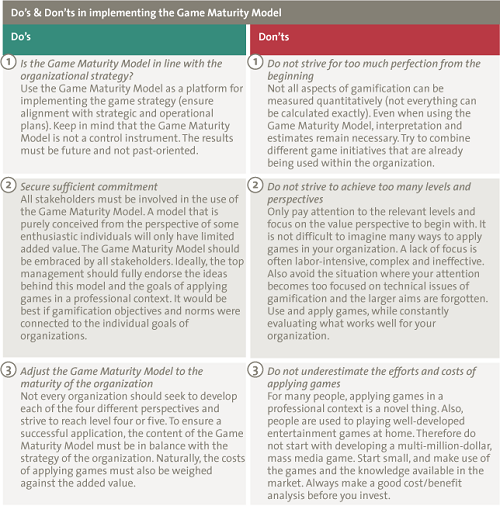Gaming is no longer the sole domain of tablet based farm games or massively multiplayer online role-playing games, as global corporates are focusing on applied gaming to help them into the next era of technology. For instance ING shows that with the use of gaming they are able to solve the most complex challenges in their IT landscape. Ultimately, applied gaming will become a tool for IT organizations to consider as they approach new targets or strive to realize their ambitions for positive change.
Introduction
Nowadays, all CIOs need to go to some lengths to perform in their traditional IT landscape and in the field of digitalization. In the face of the intensifying need to drive growth and push IT, companies are compelled to build new technology-enabled business capabilities. Finding themselves struggling to cost-effectively develop and operate such capabilities what with their aging and overly complex systems, enterprises are increasingly turning to information technology (IT) transformation to free up discretionary spending capacity and renovate their IT organizations.
The toolkit of CIOs to transform their IT organizations and IT landscape to adapt them to this new era contains many methodologies and approaches. Lean IT, Scrum and Agile have been adopted all over the world, but in some cases a different approach is required. This article introduces a lesser-known and new approach for CIOs to change IT organization, namely Applied Gaming.
In this article we go deeply into the case of ING Bank, who have explored and implemented the use of gaming to change their IT organization and IT landscape. First, however, a short introduction to the concept of applied gaming is presented. After the case study, the perspective is broadened towards approaches for companies with respect to applied gaming. The Game Maturity Model, which helps companies determine a successful approach, is introduced and do’s and don’ts are listed.
Applied Games
By the age of 21, a typical young American has spent around 10,000 hours playing computer and video games ([McGo11]). Writer Malcolm Gladwell has famously suggested that people who have practiced a skill for 10,000 hours are likely to become experts at it by that age. Therefore it is easy to understand why airlines, armies and service providers are using gaming to engage with people (staff, customers, the general public) in new, more efficient and effective ways. Employees in the IT department are likely to relate to and appreciate games at an above-average level. This provides the CIO with an opportunity to add another tool to the (IT) Transformation Toolbox. Gamification is no fad. Within five years, it will play as crucial a role in transforming internal processes, transformation and innovation as social media has done in revitalizing customer interaction. The applied gaming market (use of gaming for something other than pure entertainment) is estimated to be worth $15 billion globally, and is expected to be more lucrative than the traditional games market (currently worth $70 billion) within five years. It is expected that applied games will earn a central role in IT transformations during the same period. Gaming is already facilitating new kinds of collaboration and innovation. How organizations approach this opportunity will vary depending on their agenda and the readiness of their operations to realize its potential.
Applied Games and Gamification
Serious or applied games are models or simulations of real-world events or processes, designed for the purposes of problem-solving and learning. Although applied games are entertaining, we feel that their main purpose is to change the behavior of organizations and human beings. In this article we use the term “applied gaming” instead of “serious gaming”, the reason being that in our view “serious gaming” is a contradiction in terms. “Serious” usually means “no fun at all”. Fun is a characteristic of all games, although some games have serious applications. “Serious gaming” also implies that some games are not serious. This is not the case.
Applied games are frequently used in the context of gamification. Applied games, similar to entertainment games, are (digital) products which are designed by Game studios. Gamification is the use of game mechanics and game design in non-game scenarios (in the financial services industry, for example) in order to change behaviors and increase the motivation to change. Typically, gamification includes developing processes and applications that in the first place aim to entice users to participate, and next to engage them so they will share and interact in an activity or community. Gamification is a method for engaging people in desired behaviors, while their involvement and pursuit of these behaviors are in the process of solving their problems. Essentially, it takes advantage of the psychological predisposition of humans to engage in gaming. Within a game setting, players have a safe environment to experiment with complex concepts. The learning effect and transfer of knowledge is also much more effective when players experience the concepts themselves, rather than when they are merely explained to them.
Using games or applying game elements is not a new concept. The military have been using war games in order to train strategic skills for a long time. In addition, there are many games focused on policy and management issues. More focused sub-groups have appeared, including Games for Change, which focuses on social issues and social change, and Games for Health, which addresses healthcare applications.
ING Bank and the IT Transformation Challenge
IT Organizations face the challenge of controlling an IT landscape which is growing more complex by the day. Applications owners and holders have or at least should have knowledge of the applications within their domains. However, present-day applications are never standalone. They often have numerous interfaces, and process many transaction steps without human interference. Cross domain knowledge of a chain of applications is often lacking, but essential when incidents occur and when changes to applications need to be tested and deployed. Mathematical models provide the opportunity to digitalize complex chains and to improve the predictability of incidents.
The ING Chaingame is one of the first examples of gaming applied to IT Transformations. The goal of Chaingame is to train DevOps employees on the IT chains that together form the IT landscape of an organization.
The Chaingame aims at developing chain-awareness in IT employees through applied gaming. This can result in error detection before incidents occur, optimization of the IT landscape, and improved predictive capabilities to help prevent such incidents.
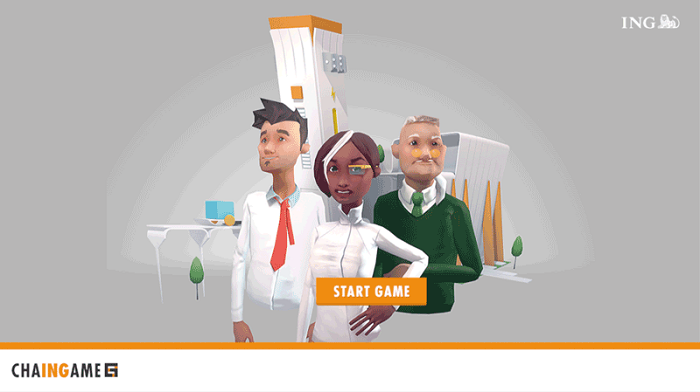
Figure 1. The ING Chaingame.
Dutch games-studios Little Chicken Game Company and QLVR were asked by ING to develop an applied game which enhances IT chain-consciousness. As ING realized that they are becoming more and more of an IT company which offers banking products, they decided that deep knowledge of their IT landscape gives a competitive advantage that will stimulate the innovation of topics such as predictive banking and online transaction processing. The goal of Chaingame is to increase knowledge transfer by a factor 4 compared to traditional learning methods .
Gameplay of the IT Transformation Game: “Chaingame”
Chaingame is a simulation game in which the different parts of the IT landscape are mapped in a city landscape. By using a city landscape model that represents the IT landscape, the game enhances the visual representation of complex landscapes, and connected complex challenges. This enables the IT specialists both to improve the architecture and stability of the landscape and to transform the IT landscape to a high extent.
For instance, applications are modelled as towers that can be configured in terms of CPU power and storage. The towers receive requests through connections and pass on the data to the next application in the chain. At the beginning of the chain, there is a Bankshop with customers who have questions. These form the initiation of the data passing through the IT chain.
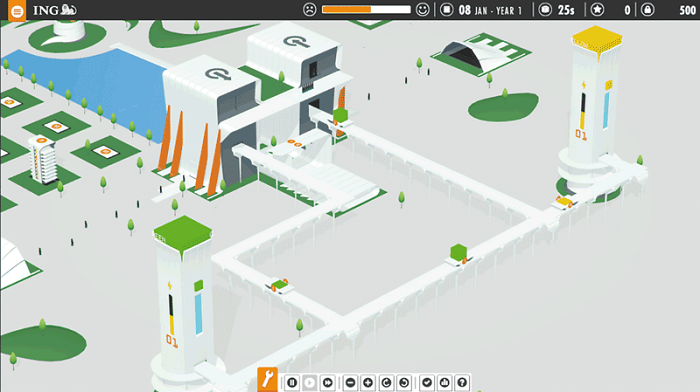
Figure 2. The IT landscape as a city in the ING Chaingame.
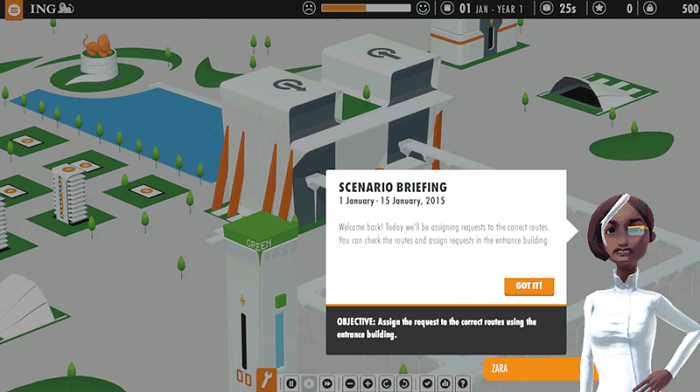
Figure 3. The game provides scenarios for players to solve specific challenges.
The game can be played in three modes. There is a one-minute challenge mode which draws the player’s attention to the game. Secondly, there is a knowledge transfer (team) competition. Lastly, there is a career mode in which the player faces scenarios that are becoming more complex as the player advances. The scenarios consist of IT Chains and data streams which have been gathered from real life situations. The algorithms which determine the behavior of the game were developed by the Centrum Wiskunde & Informatica (CWI) and the Mathematics and Informatics Department of the Vrije Universiteit, Amsterdam, in close cooperation with ING. Playing the scenarios results in an increased insight into and consciousness of the IT chains of the organization. The insights change the behavior of employees in terms of improving their ability to solve capacity issues, for example, and optimizing the performance of the IT chain. At the same time it enables a better focus on customer satisfaction: the main rewarding system in the game.
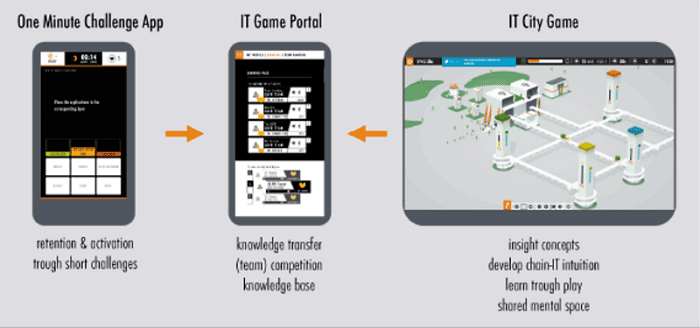
Figure 4. The three modes of the ING Chaingame.
When using the simulation, the employees share the IT problems they are struggling with. In addition to using the scenarios that are built into the game, players have the option to create their own scenarios and send these to others. The advantage of a simulation game in this mode lies in the fact that a common language is created. One language and a stimulating interactive environment encourages the sharing of communication knowledge and creates a shared understanding of the IT chains of the organization.
Development and First Results of Chaingame
The basic concept of the gaming blend is based on the Theory of Planned Behavior of Ayzen. They have used the insights from behavioral sciences to make informed design decisions. The development of a game such as this would be impossible without an Agile workflow. Although the overall approach was defined upfront, the translation of complex IT concepts into a simplified but still realistic metaphor was a process of discovery and small experiments. This worked very well because of the intense involvement of ING’s IT-experts, CWI’s scientists, the game designers and developers of QLVR & Little Chicken throughout the process. Users were involved all the time, not only in usability testing, but also in qualitative learning effect tests and interviews.
The initial reactions from developers varied from skeptical to enthusiastic. More interesting was the fact that after playing the game for a while, the skeptics usually became more interested as they were able to recreate incidents and found out that the game really emulates the way their systems interact. One of the tests was scheduled for one hour with about 20 people. The meeting extended to over 2 hours, because players became so involved.
Currently the game is being introduced on a larger scale to the Savings and Loans IT department of ING. The definitive results still have to be determined in a larger scale effect test, with a control group. But the small-scale acceptance tests and effect tests are promising.
The game blend is an excellent way to incorporate complex knowledge into the daily routine of development teams, which is why in the next steps the game will be expanded using new features like the interaction between software-layers on a server. Furthermore, the developers are studying how the game engine can be applied to other queuing problems, such as planning personnel at service-points.
How to Start Gaming
Applied games are a cool and innovative tool which many people are keen to introduce to their organizations. However, determining the right starting point, approach and securing sufficient budget is often difficult. A game maturity model is helpful in supporting a successful introduction.
Game Maturity Model
To what extent IT organizations benefit from process, task and change gamification depends on their vision, on how they incorporate the medium into their organizations, and how they build it into their strategy and governance. The most productive way to realize this is by using a maturity model. KPMG has developed a model specifically intended for gamification ([Boer13]). This can help organizations determine exactly where they are – and where they want to be in future – on a continuum where immaturity is the very start of the journey (experimentation), and maturity represents the most advanced use cases supported by a holistic vision and robust roadmaps ([Lee07]). The model allows for differences in purpose, approach and maturity at each stage. For example, an organization may use a very advanced, multiplayer game in one specific area, or a simple game that can be repurposed many times. Some games will have numerous benefits – better training of staff, lower costs and greater employee engagement – whereas others could satisfactorily serve one purpose. Ideally, a game would have a wide range of advantages and pave the way for extensive re-use right across the organization and beyond.
The example of the IT Transformation Chaingame gives a flavor of the kind of initiative that could work well for IT organizations as they start to explore gaming. Even if it feels too early to develop wider ambitions – due to budgetary pressure or the need to establish partnerships and engage stakeholders – it is worth keeping the big picture in mind from the start. It is vital that preliminary initiatives do not end up hampering future development. With KPMG’s game maturity model, you can highlight every option available to you and explore the wider implications of each decision.
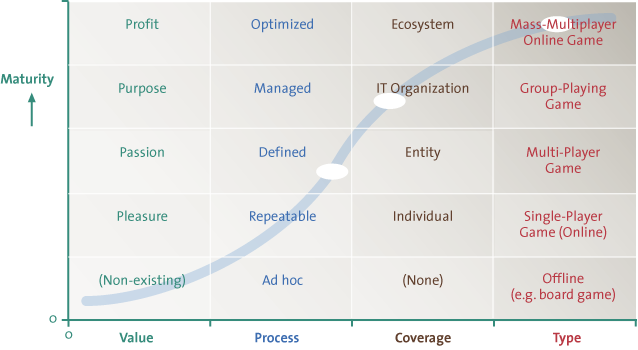
Figure 5. KPMG’s game maturity model ([Boer13]).
Don’t Be Afraid to Experiment
Even IT organizations that have not formulated long-term plans and strategies can experiment with gaming. Building a proof of concept will strengthen the business case, and inspire potential stakeholders by giving them something tangible to review. Ultimately, applied gaming is a tool for IT organizations to consider as they approach new targets or strive to realize their ambitions for positive change ([Boer15]). In this sense it is no different from other technologies: to be effective it needs to be part of an overarching strategy and seen in conjunction with other solutions rather than in isolation. There is no substitute for engaging users in developing a new game. Getting their input at an early stage will help ensure that they will use, enjoy and promote the game later – and the more engaged, rewarded and motivated people feel when they play, the more likely the investment is to pay off.
What You Should Do As a CIO
Ensure the game maturity model aligns with your broader organizational or IT strategy ([Boer15]).
Use it as a platform for implementing a game strategy that fits your operational plans as a CIO. Make sure all the necessary stakeholders are committed to the use of the game maturity model. Ideally, the top management should endorse the model and the idea of applying gaming in a transformation context. Where possible, link plans and goals to specific aims of employees. Adapt the game maturity model to your organization’s maturity when embracing innovative processes and tools. Assess the costs of introducing or developing applied games against the expected added value. Try to combine – and extend – game initiatives in use within the organization.
Applied gaming can be very powerful for your organization. Together, the right people can achieve goals which may have been too complicated or complex to acquire at first. By modeling the challenge with the use of game techniques, a joyful environment actually helps create the next level of competitive advantage for your organization.
Five mistakes to avoid
- Don’t aim for perfection from the start. Not every aspect of gamification can be measured quantitatively.
- Don’t strive to achieve maturity in too many ways at once. Start with key targets.
- Don’t get too immersed in technical detail. Use and apply games, while continually evaluating what works for your organization.
- Don’t underestimate the effort and cost involved in harnessing games. By and large, applied gaming is new to many organizations. Where possible make use of existing games and knowledge.
- Don’t neglect the importance of a robust cost/benefit analysis before and after investing.
Project : Gamification & Informal Learning
Background
Current IT systems and their corresponding IT landscapes are becoming extremely complex and error-prone. The service to end-users is delivered via long chains of components spread over many departments. At the same time DevOps people are asked to make sure that system(s) under their command provide the right service levels to customers and employees in their distinct roles. For existing systems it is a cumbersome job to gain the required knowledge to obtain operational control of components and the chain.
It is a fact that the ING CoreBank program has invested extensively in the robustness and reliability of the chain as well as its components, including a monitoring system to watch and safeguard the activities. A major problem, however, is the transfer of knowledge and skills with regard to the chain to its future DevOps and datacenter Master Control Room (MCR) staff.
Documentation can only be of limited help in acquiring the required knowledge and experience to manage such systems (compare it with learning to fly with only technical documentation and manuals instead of training on the job). The main experience comes from a daily practice of the behavior of the system.
To improve this situation they ran a survey with the CoreBank Loans system to examine the capability of a gaming approach. This resulted in a promising pre-version of a prototype, which was elaborated in conjunction with QlvR (gamification company linked to UU).
Objectives of the project
Deliver a game and prove that gamification can significantly improve the way we transfer knowledge and skills (in this case of CoreBank Loans system monitoring) to DevOps and MCR personnel by:
- Creating a meaningful learning environment
- Remaining close to people’s daily activities
- Seamlessly linking up with their present and future educational needs
- Using proven educational/gamification principles
- Showing that IT people are essentially “gamers” against a strong enemy: “technology”
- Showing that the reward of the game motivates them to acquire knowledge rapidly.
- Measuring improvement in knowledge transfer
Literatuur
[Boer13] J.C. de Boer, A. Geert and P. Adriani, Game Maturity Model, Compact 2013/4.
[Boer15] J.C. de Boer, Power of Play, Healthcare 3.0, 2015.
[Lee07] J. Lee, D. Lee and S. Kang, “An Overview of the Business Process Maturity Model (BPMM)”. In: Advances in Web and Network Technologies, and Information Management. Berlin Heidelberg: Springer, 2007, pp. 384-395.
[McGo11] J. McGonigal, Reality is Broken: Why Games Make Us Better and How They Can Change the World. New York: Penguin Press, 2011.









